LOOK: Taguig architect creates new designs for post-COVID jeepneys
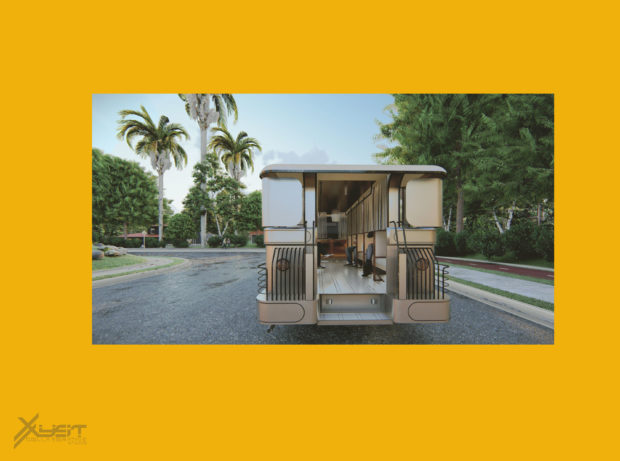
Image: Courtesy of architect and product design manager Jaecelle Marie Gecolea of the XYST Collaborative Studio
It is no secret that the COVID-19 pandemic will have a long-lasting effect on the country–and the rest of the world–and public transportation will not be returning to what it used to be anytime soon.
Even if jeepneys will still not be allowed when Metro Manila enters a general community quarantine (GCQ) period starting June 1, an architect from Taguig City is already preparing for how she sees the future transportation, particularly the jeepneys, will take shape.
Jeepneys outfitted with dividers, curtains and new modes of payment using pails or tubes—this is how architect Jaecelle Marie Gecolea envisions them in the post-COVID Philippines.
As to why Gecolea decided to pursue this project, she noted that “the Philippine jeepney has been part of our local commuter culture” due to its iconic vibrant designs, and that this industry is now in a critical situation due to the pandemic.
“To help this sector, I proposed an alternative design solution to assist our jeepney drivers/owners, particularly modifying the interior of the unit for the safety of the passengers. Moreover, it would also be an opportunity to expose the creativity and the madiskarte (resourceful) of Filipinos,” she said.
Seating
To promote physical distancing, Gecolea’s seat design includes dividers while also complying with the government’s 50-percent capacity rule on public transportation.
Each seat should also be marked with a letter or other markers for an easier transaction between driver and commuter, according to Gecolea. She added that this system should also help make contact tracing more convenient if needed.
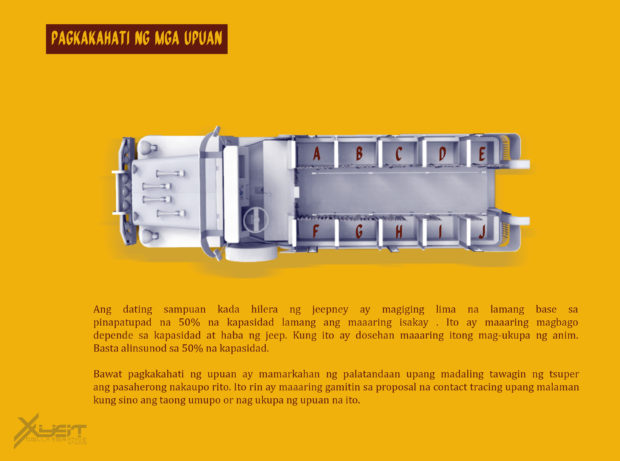
Image: Courtesy of architect and product design manager Jaecelle Marie Gecolea of the XYST Collaborative Studio
Dividers can be made of wood, polyvinyl chloride (PVC) plastic or metal covered with plastic, tarpaulin or other lightweight materials.
To minimize contact between passengers facing each other, however, Gecolea proposes to put curtains in front of each seat that should only cover passengers’ upper bodies.
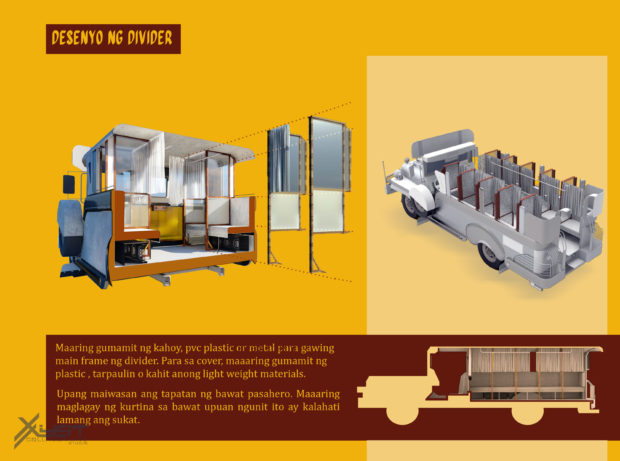
Image: Courtesy of architect and product design manager Jaecelle Marie Gecolea of the XYST Collaborative Studio
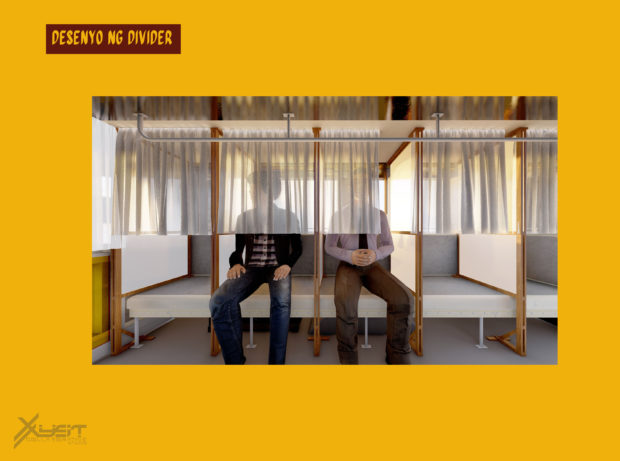
Image: Courtesy of architect and product design manager Jaecelle Marie Gecolea of the XYST Collaborative Studio
Payment systems
As the traditional passing of fares between jeepney passengers and drivers goes against physical distancing measures, Gecolea proposes four ways to mend this: First, the use of inclined tubes; second, the use of coin banks; third, the use of pails and a pulley system; and fourth, the use of mobile apps.
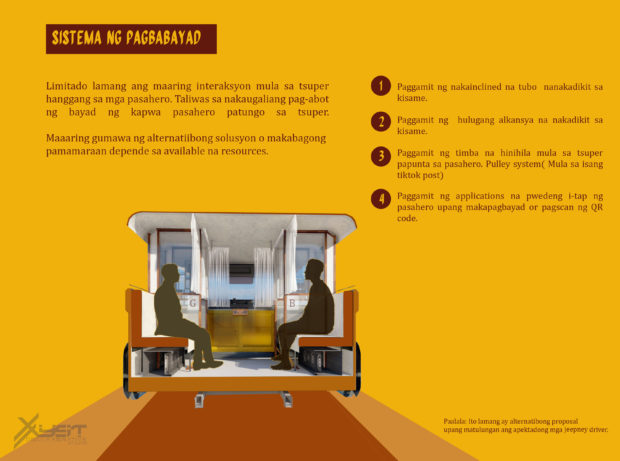
Image: Courtesy of architect and product design manager Jaecelle Marie Gecolea of the XYST Collaborative Studio
For the tube system, the architect proposes the use of c clamps or other materials that can support the tubes, into which passengers will insert their fares.
These tubes, which should be inclined by two degrees, will allow money to flow and drop into a box, which could be made of acrylic glass or any other lightweight material.
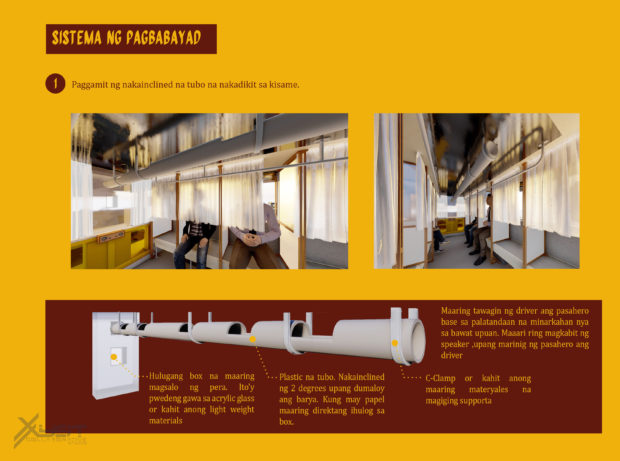
Image: Courtesy of architect and product design manager Jaecelle Marie Gecolea of the XYST Collaborative Studio
Another simpler approach is to provide passengers with coin banks attached to the jeep’s ceiling. Gecolea noted that these banks should have locks to avoid theft.
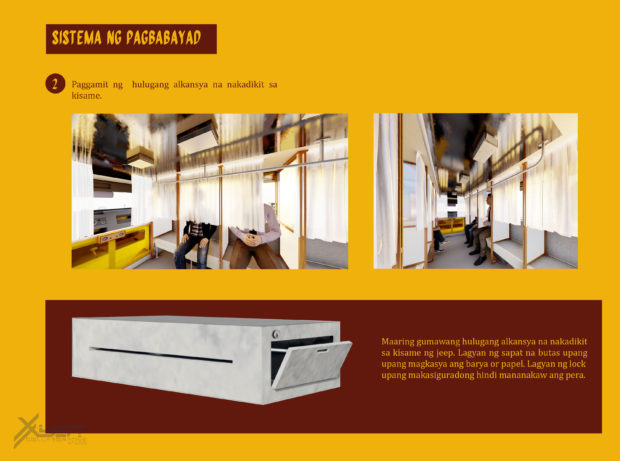
Image: Courtesy of architect and product design manager Jaecelle Marie Gecolea of the XYST Collaborative Studio
Another proposal is the implementation of a pulley system and a pail, into which passengers can drop their fares and move around to allow the easy flow of money between passengers and drivers.
Gecolea also noted that for the idea, she got the inspiration from a TikTok post.
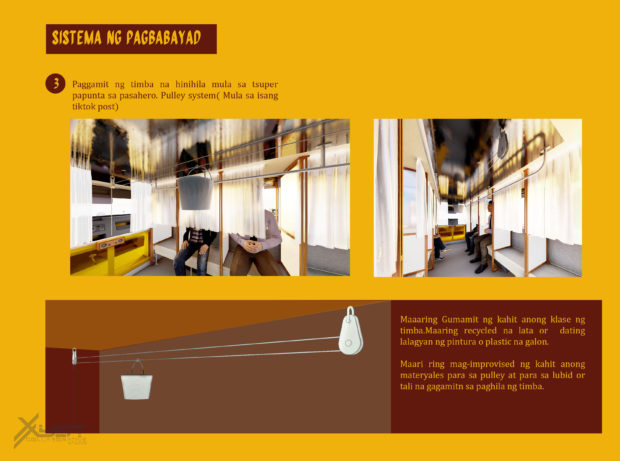
Image: Courtesy of architect and product design manager Jaecelle Marie Gecolea of the XYST Collaborative Studio
Lastly, Gecolea proposes a more modern approach: providing QR codes beside seats so passengers can simply tap and pay using mobile banking apps on their phones.
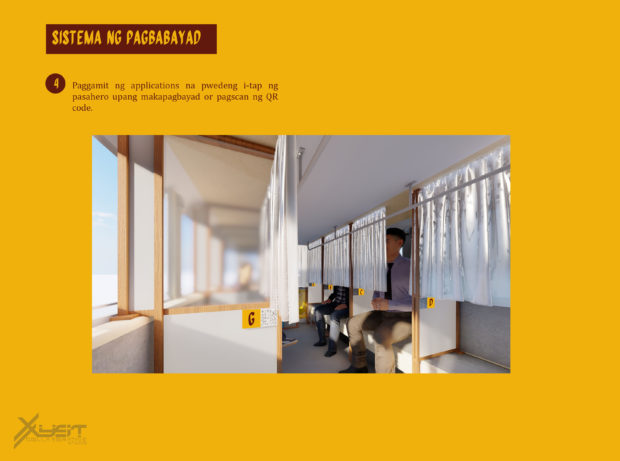
Image: Courtesy of architect and product design manager Jaecelle Marie Gecolea of the XYST Collaborative Studio
Cleanliness
As cleanliness is one of the most important factors in fighting the virus, Gecolea’s design includes the outfitting of containers for alcohol, hand sanitizers or even face masks near the jeepney entrance.
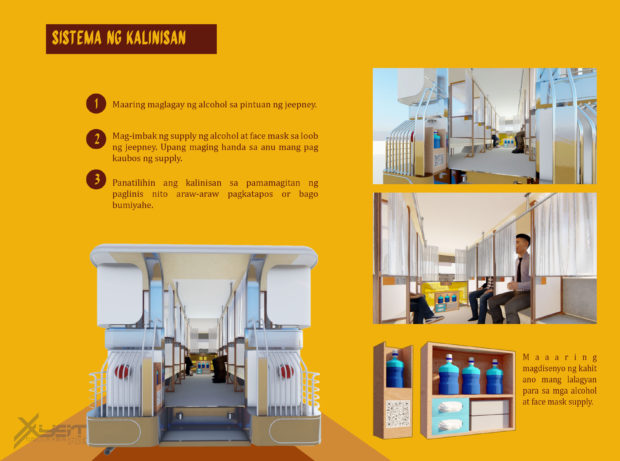
Image: Courtesy of architect and product design manager Jaecelle Marie Gecolea of the XYST Collaborative Studio
Gecolea also stated that she believes the proposals are feasible as the materials are locally available, but noted that it is still up to jeepney drivers and owners what kinds and methods they would like to apply.
“Since everyone is limited on their budget and our jeepney unit design are not standardized, the size and dimension vary. This gives everyone the freedom to customize their jeepneys individually, thus the cost will depend on the materials that the jeepney driver and operator will use,” she explained.
“I personally consider this proposal to have [a] multi-faceted benefit because we will be able to solve and propose an alternative solution while preserving the creative spirit of the ever-evolving Philippine jeepney,” she added.
Jeeps for the ‘better normal’
Gecolea said her designs are fit for the “better normal,” a term she prefers to use instead of “new normal,” as “the transition phase of the economy is not immediate.” “When you say better normal, you are considering the available resources to innovate and [propose] for the transition of the economy without leaving the other sectors behind,” she explained.
“Consultation is the key. Policies must be ambitious but politically and economically realistic,” she added.
Gecolea also shared that in creating the designs, she also took note of “the passenger and driver experience and behavior in order for me to study and analyze the constraints or effects of social distancing because of [COVID-19].”
“I was inspired to do this because my father is a machinist of vehicles (mostly jeepneys), thus his work is affected. As an [architect/designer], I also think that we have social responsibilities to think, help and innovate something that could help revive our economy without leaving the other sectors behind,” she said.
Gecolea, who is behind the XYST Collaborative Studio brand, said she has already pitched the idea to the local government unit (LGU) of Taguig.
The architect noted that the LGU’s social media account was very responsive and that they told her that her designs have already been pitched to an appropriate department.
INQUIRER.net, meanwhile, contacted the LGU to get an update on its response to the proposal, but has yet to receive a reply.
Gecolea has also reached out to a local ride-hailing app for a partnership and to develop a venue that can help jeepney drivers provide services, but has yet to receive a reply.
Productivity amid COVID-19
Gecolea shared that other than to help jeepney drivers, she came up with the idea to redesign jeepneys because she wants to be productive as the world goes on a pandemic-induced lockdown.
The architect, who got hired by a company on March 16–the first day of the enhanced community quarantine in Luzon–said she is currently in a “no-work-no-pay” mode.
Fortunately, she was able to land a freelance project abroad earlier this year, which gave her enough savings to survive amid her current situation.
“So for those who lost their jobs, please keep on moving and dreaming. I know that we are mentally and emotionally affected by this pandemic. This design firm was brought by my loss of job earlier this year and I believe that such empathy towards our jeepney sector brought this innovative idea,” Gecolea said.
“Also, I would like [to] encourage the LGUs to invest in hiring [urban] & [regional] planners, [architects] and even industrial designers to help them rebuild their cities to adopt a more coordinated, sustainable, and multi-sectoral approach,” she added. /ra
RELATED STORIES:
Jeepneys banned, buses allowed to operate at 50% capacity in GCQ areas — IATF
Nurse creates new face masks with higher filtration than N95 masks
For more news about the novel coronavirus click here.
What you need to know about Coronavirus.
For more information on COVID-19, call the DOH Hotline: (02) 86517800 local 1149/1150.
The Inquirer Foundation supports our healthcare frontliners and is still accepting cash donations to be deposited at Banco de Oro (BDO) current account #007960018860 or donate through PayMaya using this link.